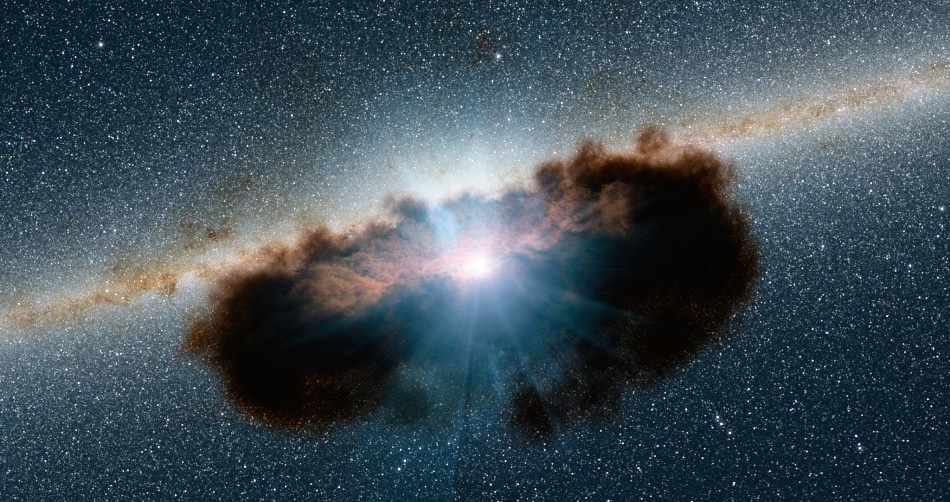Sep 28 2017
For decades, Astronomers have made attempts to understand why two of the most common types of active galaxies, called Type I and Type II galaxies, appear different when viewed from Earth.
Even though both galaxy types host voracious supermassive black holes called active galactic nuclei, which are capable of actively swallowing matter and emitting massive amounts of radiation, Type I galaxies seen to appear brighter to Astronomers’ telescopes.
 Many active galactic nuclei are surrounded by large, dark, donut-shaped clouds of gas and dust, as seen in this artist’s rendering. A popular theory known as the “unified theory” suggests that differences in the brightness of active galactic nuclei, as seen from here on Earth, are due to the placement of this donut of obscuring dust relative to our angle of observation. However, new research suggests that two of the most common types of active galactic nuclei do, in fact, exhibit fundamental physical differences in the way they consume matter and spit out energy. Image credit: NASA/JPL-Caltech
Many active galactic nuclei are surrounded by large, dark, donut-shaped clouds of gas and dust, as seen in this artist’s rendering. A popular theory known as the “unified theory” suggests that differences in the brightness of active galactic nuclei, as seen from here on Earth, are due to the placement of this donut of obscuring dust relative to our angle of observation. However, new research suggests that two of the most common types of active galactic nuclei do, in fact, exhibit fundamental physical differences in the way they consume matter and spit out energy. Image credit: NASA/JPL-Caltech
Latest research by a global team of Astronomers, with contributions from the University of Maryland, makes a key modification to a popular theory known as the unified model. Based on this model, the active nuclei of Type I and Type II galaxies have the same basic structure and energetic profile, but appear to be different only because the galaxies point toward Earth at different angles. Type II galaxies are specifically tilted such that they are obscured by their own rings of dust, thus making Type I galaxies appear brighter by comparison.
The latest results, published September 28th, 2017, in the journal Nature, recommend that Type I and Type II galaxies do not just appear to be different — they are, actually, extremely different from each other, both energetically and structurally. The main factor that differentiates Type I and Type II galaxies refers to the rate at which their central black holes consume matter and then spit out energy, according to the Researchers.
The unified model has been the prevailing wisdom for years. However, this idea does not fully explain the differences we observe in galaxies’ spectral fingerprints, and many have searched for an additional parameter that fills in the gaps. Our new analysis of X-ray data from NASA’s Swift Burst Alert Telescope suggests that Type I galaxies are much more efficient at emitting energy.
Richard Mushotzky, Professor of Astronomy, UMD and Co-author of the study
Mushotzky and his colleagues carried out the study by re-examining data from 836 active galaxies discovered by NASA’s Swift Burst Alert Telescope that powerfully emit high-energy, or “hard,” X-rays — the similar X-rays that Medical Technicians use for observing the human skeleton.
In order to measure the mass and growth rate of these galaxies’ active nuclei — the supermassive black holes at the galaxies’ centers — the Researchers employed data from 12 different ground-based telescopes spread all over the globe in order to complement the data from the Swift satellite.
This project began in 2009, as part of my doctoral work at UMD, and has radically grown with the help of more than 40 researchers across the globe. When I started out, I spent a month of lonely nights by myself at the Kitt Peak National Observatory observing a few dozen galaxies. I never dreamed we would eventually expand to such a large sample, enabling us to answer many amazing scientific questions for the first time.
Michael Koss (M.S. ’07, Ph.D. ’11, Astronomy), Research Scientist, Eureka Scientific, Inc. and Co-author of the paper
The Researchers compared differences in the X-ray spectra between Type I and Type II galaxies, and concluded that, irrespective of which way the galaxy faces Earth, the central black holes present in Type I galaxies consume matter and then emit energy at a much faster rate compared with the black holes present at the center of Type II galaxies.
“Our results suggest this has a lot to do with the amount of dust that sits close to the central black hole,” said Mushotzky, who is also a Fellow of the Joint Space-Science Institute. “Type II galaxies have a lot more dust close to the black hole, and this dust pushes against the gas as it enters the black hole.”
Astronomers preferentially studied Type II galaxies for decades mostly because the active nuclei of Type I galaxies are extremely bright, making it problematic to see the stars and gas clouds that make up the rest of the galaxy. Since the unified model proposed that all active galaxies were basically the same, Astronomers dedicated their efforts on the galaxies that host Type II active nuclei as they can be observed in a much easier manner.
But now, because our results suggest that the two types of galaxies are indeed fundamentally different, it is likely that a lot of researchers will re-evaluate their data and take another look at Type I galaxies. By putting us on a path to better understand the differences between the galaxies that host Type I and Type II active nuclei, this work will help us better understand how supermassive black holes influence the evolution of their host galaxies.
Richard Mushotzky, Professor of Astronomy, UMD and Co-author of the study